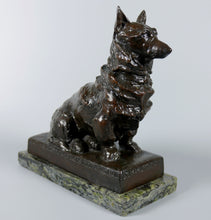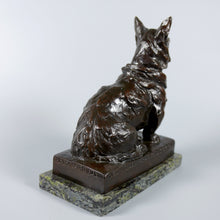King's Royal Rifle Corps - Timmy the Corgi, 1916
- Regular price
- £8,500
- Sale price
- £8,500
- Regular price
-
- Unit price
- /per
Adding product to your cart
Bronze. Model of Welsh Corgi ‘Timmy’ inscribed around the integral bronze base ‘TIMMY’ THE FAITHFUL COMPANION OF BRIGDR GENL SIR W.A.I. KAY Bt CMG DSO 60th RIFLES WARNED HIS MASTER OF A GAS ATTACK 31 V 16’. Mounted on a variegated green marble base.
The inscription to the base places Welsh corgi Timmy (dates unknown) at the centre of the British Second Army front south of the Ypres Salient on the day that he alerted his master Sir William Kay to an impending attack. The month long attempt by the German 4th Army to capture the Belgian town of Ypres had ground to a halt a week earlier and had included two large scale poison gas attacks in the vicinity of Wulverghem. On both occasions there had been mass British casualties. Timmy’s master was then serving on the staff of the 24th Division, and had only recently returned to the front after being grievously wounded in 1914.
The war diary of an artillery officer serving in the 24th Division shows that after the official end of the Second Battle of Ypres, there was continued shelling and gas alerts on the divisional front up to 31st May. On the 27th he noted ‘The wind is changing round to the N.E. and I am afraid if it goes around any more we shall be just right for a gas attack. As we burst gas cylinders in their front trenches a few days ago, we know that they have brought up their cylinders back again, and I am very much afraid that they mean to repeat their attack of the 30th of last month.’
Read more
The fact that the official histories do not record a further German gas attack in the sector at the time is perhaps the best testament to Timmy's timely warning. Sir William Kay though a staff officer, was one with an impressive record of coming to grips with the enemy and it is perfectly plausible that Timmy's vigilance combined with his pragmatism thwarted German plans.
Sir William Algernon Ireland Kay, 6th Baronet, was commissioned into the King's Royal Rifle Corps in 1896. His early service included a spell in Sierra Leone attached to the West African Regiment in 1898-99. He also served in the South African War with the 1st K.R.R.C., being present at Laing's Nek, Belfast and Lydenburg. He was promoted Captain in 1901 and served as Adjutant,of Volunteers in 1906-8, and Territorials in 1908-9. On the outbreak of the First World War he went to France with the first Expeditionary Force on the staff of Sir John French, and was awarded the D.S.O. for carrying out ‘a personal reconnaissance of great value, reaching a point within 100 yards of the enemy's outposts’ but was badly wounded. In 1916-17, he returned to France (with Timmy) to serve on the staff the 24th Division under General Sir John Capper, who held the highest opinion of his abilities. In March 1918 he was given command of a brigade in the 1st Division, but within days was wounded in the face by machine gun fire when visiting the forward posts of the Royal Sussex Regiment. He returned to the front as the commander of the 3rd Brigade, 1st Division, but was killed in action while reconnoitring a new area just a month before the Armistice in 1918. He was was awarded the C.M.G. the same year and was mentioned in despatches six times during the course of the war.
The sculptor Ernest Yarrow Jones (1872-1930) was the son of a Liverpool tea merchant and J.P. and was born in Fairfield, Lancashire. He was educated at Liverpool College, and Pembroke College, Oxford where he was elected to an open mathematical scholarship in 1891. Although called to the Bar of the Inner Temple in 1896, he pursued a career in painting and sculpture. He trained at the Westminster School of Art and at the Royal College of Art. His interests extended to manuscript illumination and book illustration. Post-war he exhibited internationally, being well reviewed at the Autumn Paris Salon of 1922. He married at Camberley, Surrey, in 1906 Mary Jane Poulter (1874-Paris 1927). She was an amateur artist and was the sister of the architects Harry Reginald Poulter (1879-1966) and Briant Alfred Poulter (1881-1972). The Yarrow Joneses settled at Black Gable, North Road, Hythe, Kent before the First World War, and in the 1920’s appear to have enjoyed a social and artistic milieu of the type characterised by E.F. Benson’s Mapp and Lucia. They had one daughter Yvonne Mirielle Yarrow Jones (1907-1992). Interestingly, Sir William’s sister and closest living relative, Annie Evelyn Ireland Kay, was a near neighbour on the Kent coast during the war.
Sources:
Edmonds, J. E. (1932) 'Military Operations France and Belgium, 1916: Sir Douglas Haig's Command to the 1st July: Battle of the Somme’, London: Macmillan.
Hamilton, LieutenantColonel The Hon. Ralph G. A. (Master of Bellhaven) (1924) ‘The War Diary of the Master of Bellhaven 1914 –1918’, London: John Murray.








